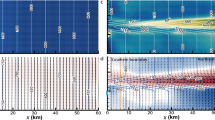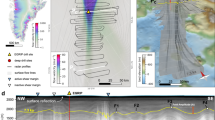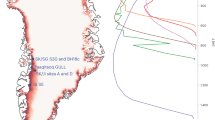Abstract
The stability of ice sheets and their contributions to sea level are modulated by high-pressure water that lubricates the base of the ice, facilitating rapid flow into the ocean. In Antarctica, subglacial processes are poorly characterized, limiting understanding of ice-sheet flow and its sensitivity to climate forcing. Here, using numerical modelling and geophysical data, we provide evidence of extensive, up to 460 km long, dendritically organized subglacial hydrological systems that stretch from the ice-sheet interior to the grounded margin. We show that these channels transport large fluxes (~24 m3 s−1) of freshwater at high pressure, potentially facilitating enhanced ice flow above. The water exits the ice sheet at specific locations, appearing to drive ice-shelf melting in these areas critical for ice-sheet stability. Changes in subglacial channel size can affect the water depth and pressure of the surrounding drainage system up to 100 km either side of the primary channel. Our results demonstrate the importance of incorporating catchment-scale basal hydrology in calculations of ice-sheet flow and in assessments of ice-shelf melt at grounding zones. Thus, understanding how marginal regions of Antarctica operate, and may change in the future, requires knowledge of processes acting within, and initiating from, the ice-sheet interior.
This is a preview of subscription content, access via your institution
Access options
Access Nature and 54 other Nature Portfolio journals
Get Nature+, our best-value online-access subscription
$29.99 / 30 days
cancel any time
Subscribe to this journal
Receive 12 print issues and online access
$259.00 per year
only $21.58 per issue
Buy this article
- Purchase on Springer Link
- Instant access to full article PDF
Prices may be subject to local taxes which are calculated during checkout



Similar content being viewed by others
Data availability
BedMachine basal and surface topography DEMs are available at NSIDC. Airborne radar data used in this study are freely available at the CReSIS website (http://data.cresis.ku.edu/). Model outputs and reflectivity data are available from the Zenodo repository: https://doi.org/10.5281/zenodo.6785041.
Code availability
The Glacier Drainage System (GlaDS) model code is available by contacting Mauro Werder (werder@vaw.baug.ethz.ch) and is also now included in the Ice-Sheet and Sea-Level System Model (ISSM), which is freely available.
References
Nienow, P., Sole, A., Slater, D. A. & Cowton, T. Recent advances in our understanding of the role of meltwater in the Greenland Ice Sheet system. Curr. Clim. Change Rep. 3, 330–344 (2017).
Iken, A. & Bindschadler, R. A. Combined measurements of subglacial water pressure and surface velocity of Findelengletscher, Switzerland: conclusions about drainage system and sliding mechanism. J. Glaciol. 32, 101–119 (1986).
Flowers, G. E. Hydrology and the future of the Greenland Ice Sheet. Nat. Commun. 9, 2729 (2018).
Dow, C. F. et al. Dynamics of active subglacial lakes in Recovery Ice Stream. J. Geophys Res. Earth. 123, 837–850 (2018).
Dow, C. F. et al. Totten Glacier subglacial hydrology determined from geophysics and modeling. Earth Planet Sci. Lett. 531, 115961 (2020).
Stearns, L. A., Smith, B. E. & Hamilton, G. S. Increased flow speed on a large East Antarctic outlet glacier caused by subglacial floods. Nat. Geosci. 1, 827–831 (2008).
Siegfried, M. R., Fricker, H. A., Carter, S. P. & Tulaczyk, S. Episodic ice velocity fluctuations triggered by a subglacial flood in West Antarctica. Geophys. Res. Lett. 43, 2640–2648 (2016).
Livingstone, S., Clark, C., Woodward, J. & Kingslake, J. Potential subglacial lake locations and meltwater drainage pathways beneath the Antarctic and Greenland Ice Sheets. Cryosphere 7, 1721–1740 (2013).
Willis, I. C., Pope, E. L., Gwendolyn, J. M., Arnold, N. S. & Long, S. Drainage networks, lakes and water fluxes beneath the Antarctic ice sheet. Ann. Glaciol. 57, 96–108 (2016).
Le Brocq, A. M. et al. Evidence from ice shelves for channelized meltwater flow beneath the Antarctic Ice Sheet. Nat. Geosci. 6, 945–948 (2013).
Alley, K. E., Scambos, T. A., Siegfried, M. R. & Fricker, H. A. Impacts of warm water on Antarctic ice shelf stability through basal channel formation. Nat. Geosci. 9, 290–293 (2016).
Marsh, O. J. et al. High basal melting forming a channel at the grounding line of Ross Ice Shelf, Antarctica. Geophys. Res. Lett. 43, 250–255 (2016).
Siegert, M. J., Alley, R. B., Rignot, E., Englander, J. & Corell, R. 21st century sea-level rise could exceed IPCC predictions for strong-warming futures. One Earth 3, 691–703 (2020).
Morlighem, M. et al. Deep glacial troughs and stabilizing ridges unveiled beneath the margins of the Antarctic Ice Sheet. Nat. Geosci. 13, 132–137 (2020).
Seroussi, H. et al. initMIP-Antarctica: an ice sheet model initialization experiment of ISMIP6. Cryosphere 13, 1441–1471 (2019).
Werder, M. A., Hewitt, I. J., Schoof, C. G. & Flowers, G. E. Modeling channelized and distributed subglacial drainage in two dimensions. J. Geophys Res. Earth. 118, 2140–2158 (2013).
Paxman, G. J. et al. Subglacial geology and geomorphology of the Pensacola–Pole basin, East Antarctica. Geochem Geophys Geosyst. 20, 2786–2807 (2019).
Ross, N. et al. Steep reverse bed slope at the grounding line of the Weddell Sea sector in West Antarctica. Nat. Geosci. 5, 393–396 (2012).
Wright, A. P. et al. Sensitivity of the Weddell Sea sector ice streams to sub-shelf melting and surface accumulation. Cryosphere 8, 2119–2134 (2014).
Rignot, E. et al. Four decades of Antarctic Ice Sheet mass balance from 1979–2017. Proc. Natl Acad. Sci. USA 116, 1095–1103 (2019).
Smith, B. E., Fricker, H. A., Joughin, I. R. & Tulaczyk, S. An inventory of active subglacial lakes in Antarctica detected by ICESat (2003–2008). J. Glaciol. 55, 573–595 (2009).
Jeofry, H. et al. Hard rock landforms generate 130 km ice shelf channels through water focusing in basal corrugations. Nat. Commun. 9, 4576 (2018).
Hofstede, C. et al. Evidence for a grounding line fan at the onset of a basal channel under the ice shelf of Support Force Glacier, Antarctica, revealed by reflection seismics. Cryosphere 15, 1517–1535 (2021).
Fountain, A. G. & Walder, J. S. Water flow through temperate glaciers. Rev. Geophys. 36, 299–328 (1998).
Chu, V. W. Greenland Ice Sheet hydrology: a review. Prog. Phys. Geogr. 38, 19–54 (2014).
Cook, S. J., Christoffersen, P., Todd, J., Slater, D. & Chauche, N. Coupled modelling of subglacial hydrology and calving-front melting at Store Glacier, West Greenland. Cryosphere 14, 905–924 (2020).
Siegfried, M. R. & Fricker, H. A. Illuminating active subglacial lake processes with ICESat-2 laser altimetry. Geophys. Res. Lett. 48, e2020GL091089 (2021).
Schoof, C. Ice-sheet acceleration driven by melt supply variability. Nature 468, 803–806 (2010).
Truffer, M. & Echelmeyer, K. A. Of isbrae and ice streams. Ann. Glaciol. 36, 66–72 (2003).
Rignot, E., Mouginot, J. & Scheuchl, B. Ice flow of the Antarctic Ice Sheet. Science 333, 1427–1430 (2011).
Seroussi, H. et al. ISMIP6 Antarctica: a multi-model ensemble of the Antarctic Ice Sheet evolution over the 21st century. Cryosphere 14, 3033–3070 (2020).
Trusel, L. D. et al. Divergent trajectories of Antarctic surface melt under two twenty-first-century climate scenarios. Nat. Geosci. 8, 927–932 (2015).
Nowicki, S. et al. Experimental protocol for sea level projections from ISMIP6 stand-alone ice sheet models. Cryosphere 7, 2331–2368 (2020).
Nicholls, K. W., Østerhus, S., Makinson, K., Gammelsrød, T. & Fahrbach, E. Ice–ocean processes over the continental shelf of the southern Weddell Sea, Antarctica: a review. Rev. Geophys. 47, RG3003 (2009).
Timmermann, R. & Goeller, S. Response to Filchner–Ronne Ice Shelf cavity warming in a coupled ocean–ice sheet model–Part 1: the ocean perspective. Ocean Sci. 13, 765–776 (2017).
Adusumilli, S., Fricker, H. A., Medley, B., Padman, L. & Siegfried, M. R. Interannual variations in meltwater input to the Southern Ocean from Antarctic ice shelves. Nat. Geosci. 13, 616–620 (2020).
Mueller, R. D., Hattermann, T., Howard, S. L. & Padman, L. Tidal influences on a future evolution of the Filchner–Ronne Ice Shelf cavity in the Weddell Sea, Antarctica. Cryosphere 12, 453–476 (2018).
Humbert, A. et al. On the evolution of an ice shelf melt channel at the base of Filchner Ice Shelf, from observations and viscoelastic modeling. Cryosphere 16, 4107–4139 (2022).
Jenkins, A. Convection-driven melting near the grounding lines of ice shelves and tidewater glaciers. J. Phys. Oceanogr. 41, 2279–2294 (2011).
Dow, C. F. et al. Basal channels drive active surface hydrology and transverse ice shelf fracture. Sci. Adv. 4, eaao7212 (2018).
Pattyn, F. & Morlighem, M. The uncertain future of the Antarctic Ice Sheet. Science 367, 1331–1335 (2020).
Bindschadler, R. et al. Getting around Antarctica: new high-resolution mappings of the grounded and freely-floating boundaries of the Antarctic Ice Sheet created for the International Polar Year. Cryosphere 5, 569–588 (2011).
Haran, T., Bohlander, J., Scambos, T., Painter T. & Fahnestock, M. MODIS Mosaic of Antarctica 2008–2009 (MOA2009) Image Map Version 1 (National Snow and Ice Data Center, 2014).
Indrigo, C., Dow, C. F., Greenbaum, J. S. & Morlighem, M. Drygalski Ice Tongue stability influenced by rift formation and ice morphology. J. Glaciol. 67, 243–252 (2021).
Wei, W. et al. Getz Ice Shelf melt enhanced by freshwater discharge from beneath the West Antarctic Ice Sheet. Cryosphere 14, 1399–1408 (2020).
Dow, C. F., Werder, M. A., Nowicki, S. & Walker, R. T. Modeling Antarctic subglacial lake filling and drainage cycles. Cryosphere 10, 1381–1393 (2016).
Dow, C. F., Karlsson, N. B. & Werder, M. A. Limited impact of subglacial supercooling freeze‐on for Greenland ice sheet stratigraphy. Geophys. Res. Lett. 45, 1481–1489 (2018).
Siegert, M. J. & Bamber, J. L. Subglacial water at the heads of Antarctic ice-stream tributaries. J. Glaciol. 46, 702–703 (2000).
Schwanghart, W. & Kuhn, N. J. TopoToolbox: a set of Matlab functions for topographic analysis. Environ. Modell. Softw. 25, 770–781 (2010).
Jeofry, H. et al. A new bed elevation model for the Weddell Sea sector of the West Antarctic Ice Sheet. Earth Syst. Sci. Data 10, 711–725 (2018).
Radar Depth Sounder Data (CReSIS, 2016); http://data.cresis.ku.edu/
Acknowledgements
We thank M. Werder for use of the Glacier Drainage System (GlaDS) model and M. Morlighem for provision of ISSM basal ice velocity and melt rates. C.F.D. was supported by the Natural Sciences and Engineering Research Council of Canada (NSERC; RGPIN-03761-2017) and the Canada Research Chairs Program (950-231237). M.J.S. and N.R. acknowledge support by the UK Natural Environment Research Council AFI grant NE/G013071/1. N.R. acknowledges funding from the Newcastle University Humanities and Social Science (HASS) bid preparation fund. K.S. was supported by NSERC and the University of Waterloo. We thank Compute Canada for provision of supercomputer resources. We acknowledge the use of data and/or data products from CReSIS generated with support from the University of Kansas, NSF grant ANT-0424589 and NASA Operation IceBridge grant NNX16AH54G.
Author information
Authors and Affiliations
Contributions
C.F.D., N.R., and M.J.S. designed and developed the project and wrote the manuscript. C.F.D. and K.S. ran the model simulations. C.F.D. conducted the analysis and produced the figures. H.J. provided radar data and figures. All authors contributed to editing the manuscript.
Corresponding author
Ethics declarations
Competing interests
The authors declare no competing interests.
Peer review
Peer review information
Nature Geoscience thanks Ian Willis and the other, anonymous, reviewer(s) for their contribution to the peer review of this work. Primary Handling Editor: Tom Richardson, in collaboration with the Nature Geoscience team.
Additional information
Publisher’s note Springer Nature remains neutral with regard to jurisdictional claims in published maps and institutional affiliations.
Extended data
Extended Data Fig. 1 Channel discharge compared to radar reflectivity.
Channel discharge for the FIS-AG catchment for the standard (base) model run. The dots show regions of positive radar reflectivity (calculated as relative values with a zero mean22) at the ice-bed interface assumed to indicate the presence of water50; negative relative reflectivity values are not plotted. Background image is the ice surface MODIS mosaic43. The extent of this region is shown by the grey box in Fig. 2c.
Extended Data Fig. 2 Basal melt and hydrology catchments.
Basal melt rate from ISSM15 with basal drainage catchments outlined for IIS (red), MIS (yellow), FIS-AG (green) and SFG (blue).
Extended Data Fig. 3 Location of radar transects shown in Extended Data Fig. 4.
MODIS ice-surface imagery of the Weddell Sea (WS) sector of West Antarctica43. The location of radar transects for IIS (A-A’), MIS (B-B’), and FIS-AG (C-C’) are plotted with white dashed lines. These radar transects are shown in Extended Data Fig. 4. The red dots are the location of modelled channel outlets over the grounding line (Fig. 2c, d) and the yellow squares, the location of sub ice-shelf channels (shown as yellow bars in Extended Data Fig. 4).
Extended Data Fig. 4 Ice shelf radar transects with incised basal channels.
Channels are incised upwards beneath floating ice for the following ice streams: (a,b) IIS (A–A’), (c,d) MIS (B–B’), and (e,f) FIS-AG (C–C’), with transects shown in Extended Data Fig. 3. Surface elevation profiles from an aircraft altimeter are plotted above each radargram (a,c,e) with depressions as a result of hydrostatic adjustment from the incised basal channels. Yellow bars show the location of the ice shelf channel as indicated by the yellow boxes in Extended Data Fig. 3.
Rights and permissions
Springer Nature or its licensor holds exclusive rights to this article under a publishing agreement with the author(s) or other rightsholder(s); author self-archiving of the accepted manuscript version of this article is solely governed by the terms of such publishing agreement and applicable law.
About this article
Cite this article
Dow, C.F., Ross, N., Jeofry, H. et al. Antarctic basal environment shaped by high-pressure flow through a subglacial river system. Nat. Geosci. 15, 892–898 (2022). https://doi.org/10.1038/s41561-022-01059-1
Received:
Accepted:
Published:
Issue Date:
DOI: https://doi.org/10.1038/s41561-022-01059-1
This article is cited by
-
Short- and long-term variability of the Antarctic and Greenland ice sheets
Nature Reviews Earth & Environment (2024)



